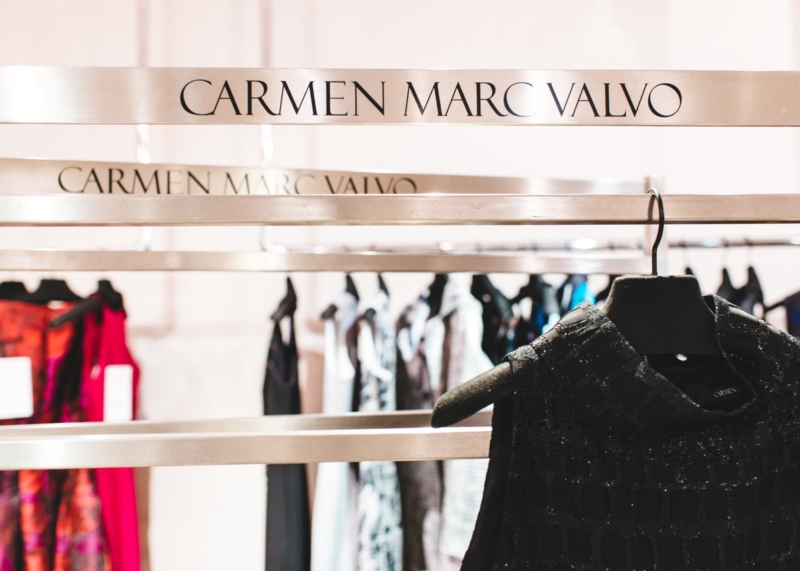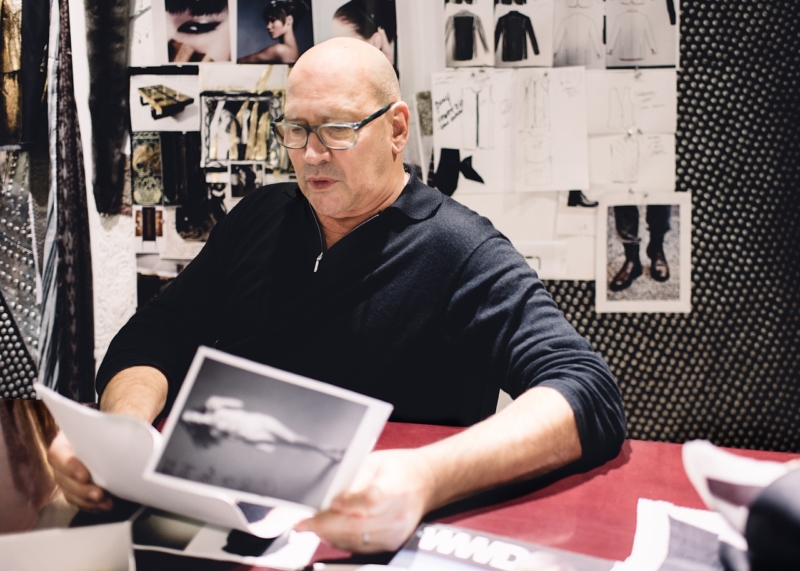You probably know that New York-based fashion designer Carmen Marc Valvo dresses some of the most powerful leading ladies in Hollywood. After 30 years in the business and stints at Christian Dior, Nina Ricci, and Bill Atkinson, he has built an iconic brand in glamorous eveningwear.
What you might not know is that he started his own line in 1989 with only $15,000 in his bank account. His hustle, business savvy, and strong will to succeed have helped him to make it in an incredibly competitive industry.
“There was no Project Runway,” he says. “There was no Internet. I want to be a fashion designer—you couldn’t Google that.”
We had the opportunity to interview him in his Garment District studio before New York Fashion Week to hear his thoughts on the changing retail landscape, finding balance when you’re starting a business, and the type of legacy he’d like to leave.

Was there an “aha” moment when you realized you wanted to be a fashion designer?
I knew I was artistic, so I played with many different ideas. I finally decided that I wanted to become a fine artist. I wanted to go to Vienna to study art, but when I got there, the school told me I had to learn German before they would accept me.
I had a girlfriend who was into fashion, so I thought that was really cool. I went to the library to find out if there were schools in New York for fashion. I finally opted to go to Parsons. When I applied, they said I was an amazing fine artist and that I should pursue a career in fine arts. But I told them “No, I want to be a fashion designer.”
Two days before the semester started, Parsons said somebody fell out and there was one opening, so I took it. It was kind of serendipitous. It was where I started on my path. Mind you, when I decided to go back to school, I was 23. Most of the kids in the class were 17 and 18, so I was big uncle or big daddy to everyone.
That wasn’t my “aha” moment. I think the biggest “aha” moment for me was spending two years at Parsons. Never graduated, but that’s because I was older. You can’t teach taste. You either have it or you don’t. They can teach you the skills that you need to perfect your craft or your artistry. I felt like I could learn as much as I could in a teaching environment, so I felt like I should go out on my own.
I went knocking on doors. I went to Geoffrey Beene first, Perry Ellis was number two, and Bill Atkinson was number three. Bill saw me and said, “Well, this is a really bad day for me because I have to tell somebody that they don’t have the job.” I said, “That’s okay. I understand.” Then he said, “No, it’s not you. It’s the person I hired yesterday.”
It was an incredible learning experience. I was with Bill for one year, and then I went to Paris working in the Paris ateliers—first at Christian Dior and then Nina Ricci. I was in Europe for almost three years nonstop. That was the basis for my education.

What brought you back to New York and made you start your own line?
I took freelance work for about 10 years after I left Europe. I was with a company where I thought I was going to stay for a while with a small equity ownership. It didn’t come into fruition, so one day, I found myself gainfully unemployed. I had just bought a house, and I thought I was going to lose everything. One day, I said I was going to start my own company, and that was 1989. So with $15,000, I started this company.
That’s the headline of my piece.
It’s crazy. It’s a true story.

So, what was the easiest and hardest part of starting your own line?
The easiest part of it was that I was forced to do it. If I was given a choice and had to think through the mathematics of it, I wouldn’t have done it. I got a collection together in 10 days, and two weeks later, I opened in Fashion Week—which is not the way it is today, but I was there with a very small line.
But with $15,000 and no outside backing, you have to be very careful not to waste your money frivolously. I couldn’t be like, “Oh my gosh, we have so many orders. Let’s redo the apartment, let’s repaint, and let’s get new furniture.” You don’t see money for another nine to 12 months. Maybe sometimes later. Even though you think you’re doing well, you have to be very frugal and very tight with that money before you spend it on something that’s not very necessary.
I think that’s the biggest problem with anybody starting out because they think everything is wonderful when they have orders coming in. They have to plan their money wisely and intelligently to get them through that initial period.

Did you have any mentors along the way?
One of the owners of Nina Ricci was kind of like my mentor because he was the one who brought me into the Nina Ricci world. He pushed me so hard to work till 2 or 3 in the morning if need be. And then I’d be back in the office for the 6 or 7 AM meeting. Timing, scheduling, deadlines—I mean he was like horrible, but the best mentor ever.
After all is said and done, how would you describe your brand?
Always evolving. Never stagnant. I just want to make sure that every collection I design is for my customer—that, to me, is who I design for. I don’t design for anyone else. If I don’t hit that trend on point at that season, I don’t care because my collection is an evolution of the season I did before. So I’m taking my customer from one season to the next. If she’s a loyal customer, she’ll be following me, and I’ll be giving her something new and exciting that she doesn’t have in her closet.

Since you’re designing for your customers, who are your customers?
I have customers who are 18, and I have customers who are over 88. Sometimes, they buy the same thing. It’s not an age. Age is not a chronological number—it’s a mindset you feel inside.
Can you tell me about some of the more memorable pieces you’ve made in the last year?
Hmm. Let me think about this. Viola Davis at the Emmys was an iconic moment in history and to be a part of that was a really exciting moment for me. I also remember when I was watching the Oscars, which was 20-something odd years ago, and that was with Julia Ormond, who was in Legends of the Fall with Brad Pitt.
Back in the day, all of the Oscars presenters and nominees used to go to Giorgio in Beverly Hills to get their gowns. Nowadays, they have stylists who get the dresses in and get them delivered in a Ferrari or a Range Rover.

With the awards season in high gear, what is the collaboration process like dressing a celebrity?
Oh my god. It’s crazy. Sometimes it works and sometimes it doesn’t. Depends on how many people are involved with the celebrity. It’s really hard. The worst thing I think is when you don’t meet the celebrity, and you’re doing it through a photograph or image. I can’t sense her personality. Usually once I’ve met the celebrity, and I know their body and their personality, it’s usually easy for me.
The first few times I dressed Queen Latifah, who I do a lot, was a little hard. I didn’t really know her size, and her measurements didn’t make any sense because I didn’t take them with my tape measure. Once I met her, I realized that I got this, and I took some measurements on my own and then I said we’re done. I send her things all the time, and they usually work perfectly, so that’s nice. But I heard actress Laura Prepon was stunning in one of my gowns at the SAG Awards.

Was there ever a moment when you realized “I made it” in the industry?
I don’t know. I still don’t think I have yet [laughs]. I mean seriously, I do evening wear. This is what I do, and I love it. We’re the unsung heroes of the industry. We’re not sportswear mavens. We don’t have $20 billion empires. We do a very specific niche market, so there’s no real gratitude or thanks or accolades given to us. There are so many talented designers who have gone out of business. You have Randolph Duke and Pamela Dennis—I can list so many. Many of them are gone because it’s very expensive to keep it running. We don’t get the recognition that we really deserve.
What kind of legacy do you want to leave?
I think what sets me apart from a lot of different designers is that I do care about how women look and feel during their red carpet moment. Whether it’s at the Emmys or the Oscars, at whatever event they go to like their wedding, their daughter’s wedding, a bar mitzvah—I really care about that. I really take pride that I’ve gone to so many special occasions in my life through the women who have worn my clothes and that I have made a mark on their special day. That would be my legacy.

Photo Credit: Katelyn Perry




